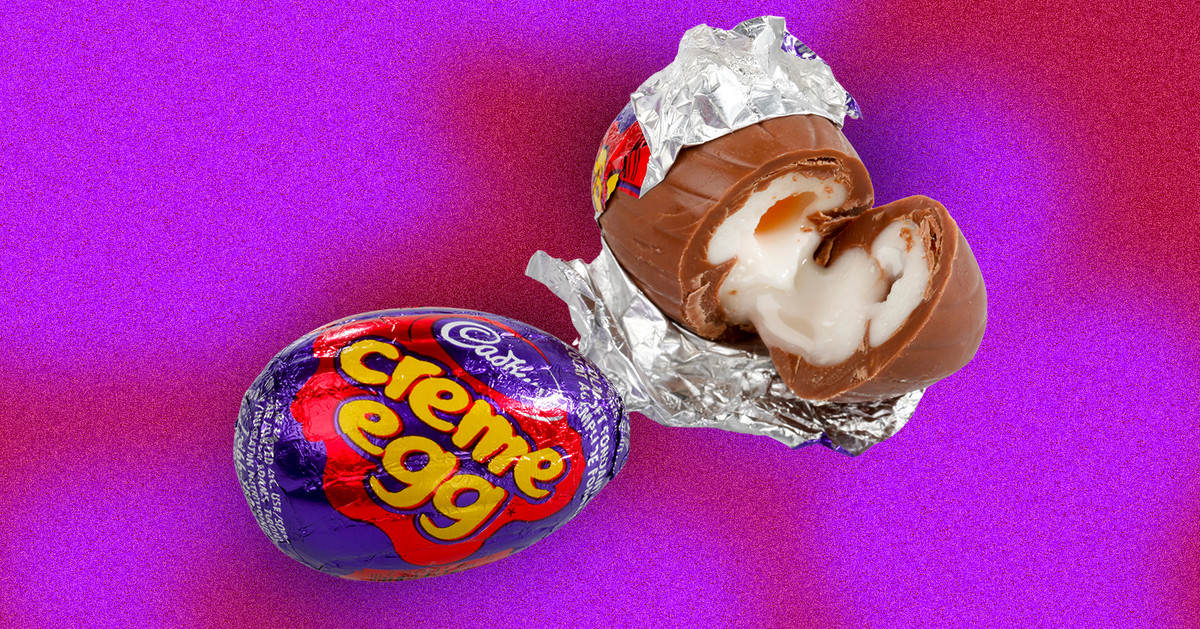
There is no clearer sign that Easter — and thus, spring — is approaching than the appearance of Cadbury Creme Eggs on candy shelves across the country. With its ovoid chocolate shell and sweet filling, visually reminiscent of the inside of an egg, the Cadbury Creme Egg is arguably Easter’s most recognizable candy. The British candy company sells more than 220 million of the eggs in Britain each year, a testament to its broad, nostalgic appeal.
But the Cadbury Creme Egg is also a candy anomaly. “There’s not another thing out there like the Cadbury Creme Egg, it’s both terrifying and delectable,” says candy historian Jason Liebig. “If you get the Cadbury Mini Eggs, for example, those aren’t dissimilar to other treats you can get throughout the year. Jelly beans are a lot like Mike & Ike’s. But a Cadbury Creme Egg? You’re not getting anything like that at any other time of the year.” And for many Americans, Easter is also the only time of year that we’re eating Cadbury-branded chocolate at all.
Founded in the 1820s in England, Cadbury is now part of Mondelez International, a massive, multinational company that operates more than 80 countries across the globe. Cadbury began filling chocolate eggs with cream in 1923, following a merger with fellow British chocolate company Fry’s. The Cadbury Creme Egg, as we know it now, was introduced in the early 1960s.
In the U.S., the memorable Cadbury Bunny commercial helped cement the Creme Egg’s status as an Easter icon. A television staple for anyone who grew up in the ’80s and ’90s, it starred a clucking bunny extolling the virtues of the Creme Egg. Perhaps you remember the 1994 iteration, which featured a pig, cat, and other critters “auditioning” for an opportunity to be the Cadbury Bunny. In 2019, Cadbury USA took the casting call public, encouraging fans of the brand to submit their own pets as contenders. Recent winners include an English bulldog, a frog, and a one-eyed rescue cat.
But while the Creme Egg has reached cult Easter candy status, Cadbury’s other offerings have a more limited presence on U.S. candy store shelves. In fact, it’s not even Cadbury who manufactures much of the Cadbury chocolate sold here — it’s Hershey, which for decades has owned an exclusive U.S. license on producing the Cadbury chocolate under the name Cadbury USA, along with other Cadbury treats like Caramello and Dairy Milk bars.
Hershey’s market dominance in the United States has, according to Liebig, largely kept Cadbury out of the American chocolate conversation. Starting in the 1960s, Hershey’s went on a bit of a buying and licensing spree. In 1963, the company merged with the H.B. Reese Candy Company, at which time it acquired the company’s now-beloved peanut butter cup. By the time the 1980s rolled around, Hershey’s grip on the candy market had only grown. It further sought to corner the chocolate market in 1988, when Hershey paid an estimated $300 million for the U.S. rights to distribute Cadbury Schweppes candies, including York Peppermint Patties, Almond Joy, and of course, the Cadbury Creme Egg.
“Their approach was to acquire competitors who might dig away at their market share, and obtain lifetime agreements so that companies like Cadbury would never be a threat again. These aren’t short-term licenses, they’re perpetual,” Liebig says. “Hershey signed some really smart agreements during this time, and they’re part of what’s turned the company into a massive global brand.”
The U.K. Cadbury under Mondelez, which also owns brands like Toblerone, Nabisco, and Sour Patch Kids, still makes chocolate — just not in the United States. And plenty of candy enthusiasts would argue that Hershey-made Cadbury chocolate just isn’t as good as it is in other parts of the globe. Last year on a trip to Ireland, I stocked up on real-deal Crunchies and Dairy Milk bars to bring home for this exact reason — the British stuff does taste richer, with a creamier, less waxy texture. And at British import stores across the country, expats and Cadbury enthusiasts are willing to pay a premium for imported chocolates that remind them of home year-round.
That premium price is likely what kept the U.K.-made chocolate from finding a major foothold in the U.S. market. If you want to buy a Dairy Milk bar from the expat-owned British Food Depot, an online retailer that specializes in U.K. groceries, you can expect to pay at least double what you’d pay in England thanks to the added cost of importing the chocolate. Most Hershey chocolate is made in North America, which means that it’s cheaper to get to grocery store shelves than a box of U.K.-made Cadbury that’s been shipped across an ocean.
“Bringing in bars from overseas makes for a premium item, and from a value perspective, buying a Hershey bar just makes more sense to most consumers,” Liebig says. “It wasn’t until the last 15 years or so that people were willing to splurge on expensive chocolate, and Hershey bars were just the classic, affordable option.”
But when it acquired the Creme Egg, Hershey clearly knew that it had a generational winner on its hands. It’s not the most luxurious chocolate in the world, and may not even be as good as what many consider “real” (read: U.K.-made) Cadbury chocolates, but there’s no denying that there are still plenty of people of all ages who are looking forward to celebrating Easter with a Creme Egg.
